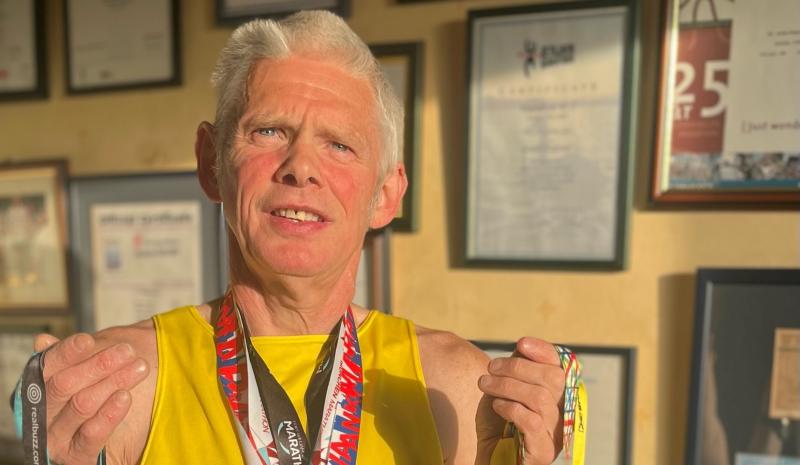News
Ensuring Galway stays to the forefront of MedTech sector

More than one in ten of Galway’s population is employed by the MedTech sector – and the recent launch of CÚRAM, the Centre for Research in Medical Devices in NUI Galway, has bolstered Ireland’s position as one of the top MedTech clusters in the world.
The establishment of CÚRAM in Galway will strengthen the sustainability of the MedTech sector by enabling industries to expand their research and development focus, while also increasing employment opportunities, according to Professor Abhay Pandit, Scientific Director of CÚRAM.
“The impact of a centre like CÚRAM will also increase the number of spin-out companies forming in the region from the centre’s research thrusts in the coming years,” he said.
“CÚRAM will also have an impact on the University in Galway, attracting new talent and top level researchers to the region, which will again build on its attractiveness as a location for new industry, both indigenous and international.”
CÚRAM represents investment of €49 million over six years from the Science Foundation of Ireland. In just over 18 months, this support has already been used to leverage a further €19 million in funding from the EU’s Horizon 2020 programme, over €4.3 million of which has been awarded directly to indigenous Irish industry.
“The MedTech sector is hugely important to the Irish economy; with over 400 companies based here, it accounts for over 29,000 jobs and is responsible for €12.6 billion worth of exports,” said Minister for Jobs, Enterprise and Innovation, Mary Mitchell O’Connor TD, as she officially launched CÚRAM last month.
“I am delighted to launch CÚRAM, a world class research centre, which will be very significant for our society and our economy. CÚRAM will also play a key role in ensuring that world class skills will be available to companies in Ireland as it is here, to futureproof the MedTech industry by providing access to unparalleled scientific expertise and innovation.”
While CÚRAM will provide huge benefits for Galway as a whole, Professor Pandit, who heads up a team of 280 people at the facility, says that Galway is also an ideal location for the research centre.
“Galway is an ideal base for CÚRAM because of the expertise and facilities provided by NUI Galway, the Clinical Research Facility and the hospitals, but also because of the entrepreneurial ethos that exists in the region,” he said.
“The existence of such a strong hub of MedTech industry in the region enhances that network of industry contacts and increases the capabilities of our industry partners of CÚRAM. Galway also produces high calibre, high quality graduates required to carry out cutting edge research in the medical devices sector and these come from across all the sciences and engineering.”
According to NUI Galway President, Dr Jim Browne, CÚRAM is already attracting new research talent to Ireland, and will train the next generation of scientists, employees and entrepreneurs in this sector.
“The calibre of our graduates in this field is extremely high, and they are inspired by the exciting potential of the sector. One example of CÚRAM’s direct co-operation with industry is through MedTrain, a new industry academic fellowship programme which will see 31 researchers enrol with CÚRAM’s Investigators as fellows in the next four years with support from EU’s Horizon 2020 programme,” he said.
MedTrain will roll out over the next four and a half years and will offer 31 prestigious two-year postdoctoral fellowships to experienced researchers in the area of medical device research and development, including tissue engineering and regenerative medicine, biomaterials and drug delivery, glycol and protein engineering and neuromodulation and medical device design.
“The MedTrain programme will provide a chance for researchers to enhance their creative, entrepreneurial and innovative potential. For anyone wishing to diversify their skill set, through advanced training, international and inter-sectoral mobility, in the area of medical device research and development, this will be a really valuable opportunity,” Professor Pandit explained.
“CÚRAM works closely with academics, industry and clinicians and this programme will further enhance those networks across Europe and internationally which are critical for driving medical device research and development. Participants will have access to state-of-the-art infrastructure and teams of multi-disciplinary experts in the broad area of medical device research and development.
“It will deliver high quality tailor-made training for fellows that will equip them with skills and experience required to meet their career goals as well as facilitating their engagement with industry through non-academic secondment partnerships,” he said.
Global demographic shifts mean we are living longer, but with chronic illnesses such as diabetes, Parkinson’s and heart disease. The research approach at CÚRAM is collaborative, multidisciplinary and informed from all perspectives so that it translates from basic research to clinical application as efficiently and quickly as possible.
“Years of strategic planning and investment have made Ireland a global hub for medical technology. CÚRAM is the next chapter in our MedTech success story. To ensure that the industry stays here and grows here, CÚRAM researchers are developing partnerships with Ireland’s 300-strong MedTech company base to discover new technologies for global use,” said Professor Pandit.
“We are all getting older and chronic diseases are increasing in populations. We at CÚRAM understand that both clinical and economic needs to be met and our goal is to come up with affordable solutions.
“Research into medical technologies has been going on in Irish Universities for at least two decades. Ireland is now the highest per capita exporter of medical technologies in Europe. It is a sector that needs to be nurtured and these factors have led to the establishment of CÚRAM.”
The workforce in the medical devices industry is very highly skilled, according to the professor, and the impact of the sector on the wider economy is also very large.
“It is estimated that for every one direct job in the industry, a further 3.75 are supported indirectly. This means that the industry is responsible for over 100,000 jobs within Ireland. When you walk down Shop Street in Galway, it is very unlikely that you will meet someone who is not connected in some way to the medical device industry. Being established in Ireland, CÚRAM is destined to have a global impact on healthcare,” said Professor Pandit.
“We are delighted to have the Centre launched so effectively, and we have raised some awareness of the huge potential of CÚRAM and the MedTech sector. What we need to do now is ensure that we maintain the level of energy, investment and collaboration that we have built to this point and nurture these partnerships so that we are in a position to continue our work and maintain and strengthen Ireland’s position as a global hub for medical device research.
■ For more information on CÚRAM, see www.curamdevices.ie
Connacht Tribune
West has lower cancer survival rates than rest

Significant state investment is required to address ‘shocking’ inequalities that leave cancer patients in the West at greater risk of succumbing to the disease.
A meeting of Regional Health Forum West heard that survival rates for breast, lung and colorectal cancers than the national average, and with the most deprived quintile of the population, the West’s residents faced poorer outcomes from a cancer diagnosis.
For breast cancer patients, the five-year survival rate was 80% in the West versus 85% nationally; for lung cancer patients it was 16.7% in the west against a 19.5% national survival rate; and in the West’s colorectal cancer patients, there was a 62.6% survival rate where the national average was 63.1%.
These startling statistics were provided in answer to a question from Ballinasloe-based Cllr Evelyn Parsons (Ind) who said it was yet another reminder that cancer treatment infrastructure in the West was in dire need of improvement.
“The situation is pretty stark. In the Western Regional Health Forum area, we have the highest incidence of deprivation and the highest health inequalities because of that – we have the highest incidences of cancer nationally because of that,” said Cllr Parsons, who is also a general practitioner.
In details provided by CEO of Saolta Health Care Group, which operates Galway’s hospitals, it was stated that a number of factors were impacting on patient outcomes.
Get the full story in this week’s Connacht Tribune, on sale in shops now, or you can download the digital edition from www.connachttribune.ie. You can also download our Connacht Tribune App from Apple’s App Store or get the Android Version from Google Play.
Connacht Tribune
Marathon Man plans to call a halt – but not before he hits 160 races

On the eve of completing his 150th marathon, an odyssey that has taken him across 53 countries, Loughrea’s Marathon Man has announced that he is planning to hang up his running shoes.
But not before Jarlath Fitzgerald completes another ten races, making it 160 marathons on the occasion of his 60th birthday.
“I want to draw the line in 2026. I turn 57 in October and when I reach 60 it’s the finishing line. The longer races are taking it out of me. I did 20 miles there two weeks ago and didn’t feel good. It’s getting harder,” he reveals.
“I’ve arthritis in both hips and there’s wear and tear in the knees.”
We speak as he is about to head out for a run before his shift in Supervalu Loughrea. Despite his physical complaints, he still clocks up 30 miles every second week and generally runs four days a week.
Jarlath receives injections to his left hip to keep the pain at bay while running on the road.
To give his joints a break, during the winter he runs cross country and often does a five-mile trek around Kylebrack Wood.
He is planning on running his 150th marathon in Cork on June 4, where a group of 20 made up of work colleagues, friends and running mates from Loughrea Athletics Club will join him.
Some are doing the 10k, others are doing the half marathon, but all will be there on the finishing line to cheer him on in the phenomenal achievement.
Get the full story in this week’s Connacht Tribune, on sale in shops now, or you can download the digital edition from www.connachttribune.ie. You can also download our Connacht Tribune App from Apple’s App Store or get the Android Version from Google Play.
CITY TRIBUNE
Galway ‘masterplan’ needed to tackle housing and transport crises

From the Galway City Tribune – An impassioned plea for a ‘masterplan’ that would guide Galway City into the future has been made in the Dáil. Galway West TD Catherine Connolly stated this week that there needed to be an all-inclusive approach with “vision and leadership” in order to build a sustainable city.
Deputy Connolly spoke at length at the crisis surrounding traffic and housing in Galway city and said that not all of the blame could be laid at the door of the local authority.
She said that her preference would be the provision of light rail as the main form of public transport, but that this would have to be driven by the government.
“I sat on the local council for 17 years and despaired at all of the solutions going down one road, metaphorically and literally. In 2005 we put Park & Ride into the development plan, but that has not been rolled out. A 2016 transport strategy was outdated at the time and still has not been updated.
“Due to the housing crisis in the city, a task force was set up in 2019. Not a single report or analysis has been published on the cause of the crisis,” added Deputy Connolly.
She then referred to a report from the Land Development Agency (LDA) that identified lands suitable for the provision of housing. But she said that two-thirds of these had significant problems and a large portion was in Merlin Park University Hospital which, she said, would never have housing built on it.
In response, Minister Simon Harris spoke of the continuing job investment in the city and also in higher education, which is his portfolio.
But turning his attention to traffic congestion, he accepted that there were “real issues” when it came to transport, mobility and accessibility around Galway.
“We share the view that we need a Park & Ride facility and I understand there are also Bus Connects plans.
“I also suggest that the City Council reflect on her comments. I am proud to be in a Government that is providing unparalleled levels of investment to local authorities and unparalleled opportunities for local authorities to draw down,” he said.
Then Minister Harris referred to the controversial Galway City Outer Ring Road which he said was “struck down by An Bord Pleanála”, despite a lot of energy having been put into that project.
However, Deputy Connolly picked up on this and pointed out that An Bord Pleanála did not say ‘No’ to the ring road.
“The High Court said ‘No’ to the ring road because An Bord Pleanála acknowledged it failed utterly to consider climate change and our climate change obligations.
“That tells us something about An Bord Pleanála and the management that submitted such a plan.”
In the end, Minister Harris agreed that there needed to be a masterplan for Galway City.
“I suggest it is for the local authority to come up with a vision and then work with the Government to try to fund and implement that.”












